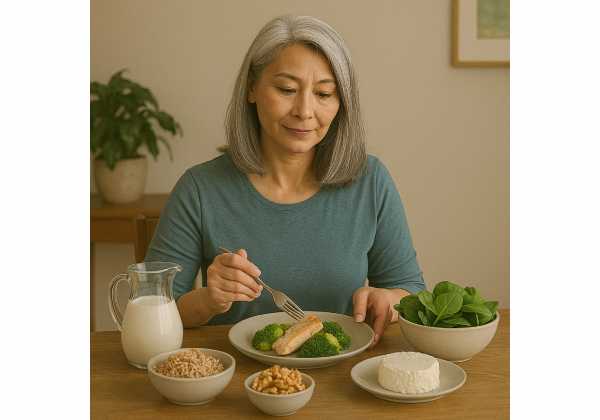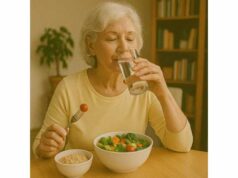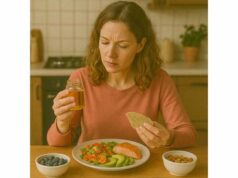
Strong bones protect more than posture; they guard mobility, balance, and everyday independence. Bone tissue never sleeps—it constantly breaks down and rebuilds—so what you eat, and how steadily you eat it, shapes your skeleton across decades. This guide turns evidence into practical moves: how to hit daily calcium from food, keep vitamin D sufficient, use vitamin K–rich choices wisely, and reach protein targets that protect both bone and muscle. We will also cover minerals that matter, lifestyle factors that nudge bone either way, a full example day, and when testing or professional input makes sense. For a wider view on how bone-supportive meals fit into healthy aging, see our primer on longevity-focused nutrition patterns.
Table of Contents
- Calcium Targets by Age and Everyday Food Sources
- Vitamin D and K: Partners in Bone Metabolism
- Protein’s Role in Bone and Muscle Preservation
- Minerals That Matter: Magnesium and Potassium
- Lifestyle Factors: Caffeine, Sodium, and Alcohol
- One Day Bone Friendly Menu Example
- Who Needs Testing or Professional Guidance
Calcium Targets by Age and Everyday Food Sources
Calcium is the structural mineral of bone, laid down as hydroxyapatite within a collagen scaffold. The body keeps blood calcium in a tight range, and if dietary supply dips, bone is mined to fill the gap. Daily targets anchor a sound plan: most adults need ~1,000 mg/day; women over 50 and men over 70 benefit from ~1,200 mg/day. The tolerable upper limit after age 50 is about 2,000 mg/day—mainly to curb kidney stone risk from high-dose supplements. You do not have to memorize every milligram; you do need predictable routines that reliably add up.
Food first works best because calcium arrives with other helpful nutrients (protein, potassium, magnesium) and tends to absorb steadily. Benchmarks that help planning:
- Dairy and fortified alternatives:
- 1 cup (240 mL) milk or fortified soy beverage ≈ 300 mg
- 6 oz (170 g) yogurt ≈ 250–300 mg
- 1 oz (28 g) hard cheese ≈ 200 mg
- Calcium-set tofu (look for “calcium sulfate”): ~250–350 mg per 100 g
- Canned fish with bones (sardines, salmon): ~200–325 mg per 85 g (3 oz)
- Fortified foods (plant milks, orange juice, cereals): 100–350 mg per serving—labels vary
- Leafy greens: bok choy, kale, and turnip greens contribute meaningfully; spinach and beet greens are high in oxalates, so their calcium is less available
Absorption improves when you spread intake across the day. Aim for 300–400 mg with two or three meals rather than a single bolus. Vitamin D status is a gatekeeper for active calcium transport in the gut, and protein supports the collagen matrix that calcium mineralizes—so think about your plate as an integrated system.
Supplements can help fill small gaps when diet falls short. Calcium citrate absorbs well with or without food; calcium carbonate absorbs better with meals. Keep any single dose ≤500 mg elemental calcium. If your food routinely provides 800–1,000 mg/day, a 200–400 mg supplement is often enough. People with a history of kidney stones, hypercalcemia, or certain medications should coordinate with a clinician before adding supplements.
A simple day that clears ~1,100 mg without pills: fortified soy latte (300 mg), Greek yogurt bowl (300 mg), salmon salad made with canned salmon and bones (200–300 mg), calcium-set tofu stir-fry (250 mg). Those anchors still leave room for greens, nuts, and whole grains that add supportive minerals.
Vitamin D and K: Partners in Bone Metabolism
Vitamin D and vitamin K do different jobs that converge in bone. Vitamin D promotes intestinal calcium absorption and helps keep calcium and phosphate available for mineralization. Vitamin K activates (carboxylates) bone proteins—most notably osteocalcin—so they can bind calcium within the matrix. When D is low, you can eat enough calcium and still fall short; when K is low, calcium may be present but not effectively incorporated where it belongs.
Vitamin D basics. Many adults run low, particularly at higher latitudes, during winter, with limited sun exposure, or when skin pigmentation and age reduce cutaneous synthesis. Food contributes modestly (fatty fish, eggs, fortified milk or plant beverages). A reasonable lab target for 25-hydroxyvitamin D is often in the 20–50 ng/mL (50–125 nmol/L) range; a clinician might personalize this. If you supplement, daily cholecalciferol (vitamin D₃) is commonly used. Extremely high intermittent doses are rarely necessary and can backfire. Remember: the goal is sufficiency, not maximal numbers.
Vitamin K in foods. Phylloquinone (K₁) lives in leafy greens and plant oils; menaquinones (K₂, especially MK-7) occur in fermented foods (natto), some cheeses, and animal products. K₁ can convert to K₂, but conversion is limited; a mixed approach—leafy salads most days and occasional fermented sources—covers your bases. Evidence suggests K₂ can maintain lumbar spine bone mineral density in some postmenopausal populations; fracture effects are mixed and may depend on baseline status and what else the person is doing (calcium, vitamin D, medications). If you take warfarin or other vitamin K–antagonist anticoagulants, keep K intake consistent and coordinate any diet changes with your prescribing clinician.
How to pair them on the plate.
- Yogurt or fortified soy with a large kale-and-herb salad
- Salmon over arugula with lemon–olive oil dressing
- Tofu miso bowl with napa cabbage and mushrooms
Small, repeated exposures matter more than rare mega-servings. If you want a concise food list for K₂, skim our focused roundup of dietary K2 options.
Two cautions. First, supplements are not magic; in community-dwelling older adults without clear deficiency, routine vitamin D plus calcium does not guarantee fewer fractures. Bone-smart meals, strength and balance training, fall prevention, and targeted therapy for osteoporosis provide the durable gains. Second, total calcium from food plus supplements should stay within age-appropriate upper limits to curb stone risk.
Protein’s Role in Bone and Muscle Preservation
Bone is one-third protein by mass, largely type I collagen. That matrix is where calcium and phosphate mineralize. Adequate protein preserves the scaffold, sustains muscle (which protects against falls), and supports anabolic signaling. With age, anabolic resistance blunts muscle’s response to smaller doses of protein, so distribution across meals, not just daily total, becomes essential.
Daily targets. For healthy older adults, a practical range is 1.0–1.3 g/kg/day, with up to 1.5 g/kg/day under clinical supervision for those with chronic illness or during rehabilitation. Equally important is the per-meal threshold: about 25–35 g protein (delivering ~2–3 g leucine) at breakfast, lunch, and dinner. For a 70-kg adult, that’s 77–91 g/day overall—often easiest to hit with a protein-forward breakfast.
Quality and variety. You can meet targets with animal or plant proteins—or both.
- Animal options: yogurt, kefir, milk, eggs, fish, poultry. These often bundle protein with calcium (dairy) and vitamin D (fatty fish).
- Plant options: soy foods (tofu, tempeh, edamame), legumes, seitan, and mixed grains with pulses. Calcium-set tofu uniquely pairs high-quality protein with absorbable calcium.
The old idea that “high protein leaches calcium” misses context. Higher protein increases urinary calcium, but it also improves intestinal calcium absorption and helps maintain IGF-1 and muscle. When calcium intake is adequate and fruits/vegetables supply potassium and magnesium, higher protein patterns are neutral to beneficial for bone mineral density and may support lower hip fracture risk in older adults.
Practical ways to clear the threshold:
- Front-load breakfast. Greek yogurt with nuts and fruit; cottage cheese with berries; tofu scramble with vegetables; or a fortified soy smoothie with soy isolate if appetite is low.
- Lunch formats that carry protein and minerals. Salmon-and-white-bean salad; lentil–quinoa bowl; tempeh on whole-grain toast with leafy greens.
- Evening anchors. Calcium-set tofu stir-fry; canned salmon (with bones) cakes; bean-and-greens stew with a side of skyr or soy skyr.
- Smart snacks. Edamame; kefir; a small whey or soy shake when meals fall short.
Pair protein intake with resistance training two to three days per week. The combination directs amino acids into muscle, improves balance, and lowers fall risk—the fastest route from nutrients to stronger bones in real life. For a step-by-step plan on spreading protein across the day, see our short guide to per-meal protein targets.
Minerals That Matter: Magnesium and Potassium
Calcium gets rightful attention, but magnesium and potassium are the quiet co-stars of bone-friendly eating.
Magnesium participates in more than 300 enzymatic reactions, including vitamin D activation and osteoblast/osteoclast function. About 50–60% of body magnesium sits in bone, where it influences crystal quality and mechanical properties. Low magnesium status tracks with lower bone mineral density in many cohorts; small trials and reviews suggest that correcting magnesium insufficiency may support bone density, particularly in postmenopausal women.
Practical targets: women generally need ~310–320 mg/day, men ~400–420 mg/day. Many adults come up short. Food-first sources you can repeat:
- Nuts and seeds: almonds (~80 mg/28 g), cashews (~74 mg/28 g), pumpkin seeds (~150 mg/28 g)
- Legumes: black beans (~120 mg/cup cooked), soy/edamame (~100 mg/cup), lentils (~70 mg/cup)
- Whole grains: oats, quinoa, buckwheat (~40–80 mg/cup cooked)
- Leafy greens: spinach or Swiss chard (~150 mg/cup cooked)
- Dark chocolate: ~45–65 mg per 30–40 g
If supplementing, magnesium citrate, glycinate, or malate are typically better tolerated than oxide. Introduce gradually (gastrointestinal tolerance varies) and coordinate with your clinician if you have kidney disease or take medications that affect magnesium balance.
Potassium helps buffer dietary acid load and may curb urinary calcium losses. Diets rich in fruits and vegetables—high in potassium, magnesium, vitamin C, and polyphenols—often associate with better bone outcomes. Adequate intake targets are ~2,600 mg/day for women and ~3,400 mg/day for men, but counting every milligram is impractical. Instead, shape the pattern:
- Build 2 cups vegetables + 1–2 cups fruit daily as a floor; push higher when appetite and energy needs allow.
- Rotate potassium-dense choices: potatoes (including cooked-then-cooled preparations), sweet potatoes, winter squash, tomatoes, beans, bananas, citrus, prunes, leafy greens.
- Use fermented dairy or kefir in sauces and dressings to add potassium and calcium together.
Magnesium and potassium reinforce the effect of adequate protein and calcium. A plate that layers legumes or tofu, leafy greens, whole grains, and fermented dairy or fortified soy creates a mineral environment where bone can build and maintain quality across decades. For food lists and kitchen ideas that emphasize these minerals, browse our quick guide to magnesium-rich choices.
Lifestyle Factors: Caffeine, Sodium, and Alcohol
Small daily habits nudge bone biology. Three levers—caffeine, sodium, and alcohol—show up in most people’s routines, so they are good places to make quiet, durable adjustments.
Caffeine. Moderate intakes (about 200–300 mg/day, roughly 2–3 cups brewed coffee or 4–6 cups tea) fit comfortably with bone health when calcium intake is adequate. Higher intakes (≥400 mg/day) can increase urinary calcium loss and may correlate with lower bone density in susceptible groups if diet is otherwise low in calcium. Two easy guards: pair caffeine with a calcium source (a latte made with milk or fortified soy; tea plus yogurt), and steer caffeine earlier in the day to protect sleep, since poor sleep increases fall risk and slows training recovery.
Sodium. Consistently high sodium raises urinary calcium losses and, over time, can erode bone when paired with low calcium and low potassium intakes. Most sodium comes from packaged foods and restaurants, not the salt shaker. A practical goal is 1,500–2,300 mg/day on average. What helps: cooking more from minimally processed ingredients; using herbs, spices, citrus, vinegar, garlic, and tomato paste for flavor; choosing reduced-sodium options for staples like broths, canned beans, and sauces; and rinsing brined items (capers, olives).
Alcohol. Heavy, regular drinking undermines bone formation, disrupts hormones, and increases falls and fractures. Light drinking shows mixed associations and is not a reason to start. If you drink, keep it modest (for many, ≤1 standard drink on days you drink, with several alcohol-free days each week), and fold alcohol into a protein- and calcium-containing meal to blunt downsides. If you’re rethinking intake, our short explainer on alcohol and aging trade-offs summarizes thresholds and safer patterns.
The bigger picture. Exercise—particularly resistance training and weight-bearing impact—signals bone to stay strong; balance training lowers fall risk; tobacco cessation protects bone and vascular health; medication reviews can identify bone-unfriendly regimens that can be optimized. When these elements line up with a mineral- and protein-replete diet, bones “hear” a clear, consistent message to maintain mass and quality.
One Day Bone Friendly Menu Example
Use this example day as a template. It aims for ~1,100–1,200 mg calcium, ~90–105 g protein for a 70-kg adult, ≥350 mg magnesium, and generous potassium from produce and legumes. Adjust portions to your energy needs.
Breakfast (25–30 g protein; ~350 mg calcium)
- Savory Greek yogurt bowl: 1 cup (240 mL) plain Greek yogurt with lemon, dill, and chopped cucumber; top with cherry tomatoes and ¼ cup chickpeas.
- Whole-grain toast with 1 tbsp tahini.
- Coffee or tea with ½ cup milk or fortified soy (adds ~150 mg calcium).
Why it works: Fermented dairy (or high-protein soy yogurt) supplies calcium and protein; chickpeas and tahini add magnesium and potassium. Pairing caffeine with calcium reduces net losses.
Mid-morning (10–15 g protein; ~250–300 mg calcium)
- Fortified soy latte or 1 cup kefir with cinnamon.
- 1 medium banana for potassium and prebiotic fibers.
Lunch (25–35 g protein; ~300–400 mg calcium)
- Salmon and white-bean salad: 3–4 oz canned salmon with bones, ½ cup white beans, arugula, tomatoes, olives, lemon–olive oil dressing; sprinkle 1–2 tbsp pumpkin seeds.
- Whole-grain roll.
Why it works: Canned salmon brings absorbable calcium; beans and seeds contribute magnesium; leafy greens provide vitamin K₁.
Snack (10–20 g protein; magnesium boost)
- Edamame (1 cup) with seaweed flakes and citrus.
- Dark chocolate (30 g) for additional magnesium.
Dinner (25–35 g protein; ~200–300 mg calcium)
- Calcium-set tofu stir-fry: 5–6 oz firm tofu with bok choy, shiitake mushrooms, bell peppers, and snap peas; ginger–garlic–tamari–rice-vinegar sauce (choose reduced-sodium tamari; add a splash of orange juice).
- ¾–1 cup cooked buckwheat or quinoa.
- Side salad of mixed greens (vitamin K₁) with a small portion of aged cheese (a natural K₂ source) if you enjoy dairy.
Why it works: Tofu adds calcium and high-quality plant protein; buckwheat and vegetables contribute magnesium and potassium; fermented elements can add K₂.
Hydration and extras
- Water or sparkling water with citrus.
- If appetite is low at dinner, add a small bedtime protein (½ cup cottage cheese or soy skyr) to secure per-meal protein thresholds and another 150–200 mg calcium.
Weekly rhythm that makes this easy:
- Anchor breakfast with yogurt, kefir, or fortified soy most days to set calcium and protein baselines.
- Rotate seafood and legumes at lunch: sardines, salmon, mackerel; lentils, chickpeas, white beans.
- Plan two tofu or tempeh dinners weekly and two fermented-dairy nights.
- Batch-prep magnesium-rich sides (quinoa, bean salad, roasted squash) to reduce friction.
- Keep sodium modest by cooking once and flavoring with herb blends, citrus, and vinegars—fewer last-minute salty take-out meals.
For step-by-step batching and freezer-friendly ideas, see our quick guide to meal prep for longevity.
Who Needs Testing or Professional Guidance
Bone health is personal. Age, hormones, medications, co-existing conditions, diet, and physical activity all shift your risk. Testing and targeted care prevent fractures and preserve independence.
1) Laboratory checks
- 25-hydroxyvitamin D: Consider testing if you have limited sun exposure, darker skin, obesity, malabsorption, bone pain, frequent falls, or medications that affect vitamin D (anticonvulsants, glucocorticoids). Treatment should be based on the result; avoid blind high-dose use.
- Serum calcium, parathyroid hormone (PTH), alkaline phosphatase: Helpful for suspected parathyroid disorders, malabsorption, or unexplained bone pain.
- Magnesium, B12, TSH, and celiac screening when clinical clues suggest deficiencies or autoimmune drivers of low bone density.
2) Bone density (DXA) and fracture risk
- Women ≥65 and men ≥70 generally qualify for DXA screening.
- Postmenopausal women and men 50–69 should consider DXA if they have risk factors: prior adult fracture, long-term glucocorticoids, low body weight, smoking, excessive alcohol, rheumatoid arthritis, or parental hip fracture.
- Clinicians often pair DXA with a 10-year fracture risk tool to guide therapy choices.
3) Medication review
- Ask about bone-unfriendly regimens (chronic high-dose PPIs, some SSRIs, long-term glucocorticoids, aromatase inhibitors without bone protection, high-dose thyroid hormone). Safer alternatives or protective measures may be available.
- If you use warfarin, keep vitamin K intake stable; coordinate any changes with your prescriber.
4) When diet or over-the-counter supplements aren’t enough
- Diagnosed osteoporosis or high fracture risk merits discussion of pharmacologic therapy (e.g., bisphosphonates, denosumab, anabolic agents). These reduce fractures beyond diet and exercise alone.
- Secondary causes (hyperparathyroidism, hypogonadism, malabsorption, chronic kidney disease) require specialist input; nutrition adjusts to the condition.
5) Red flags for earlier intervention
- Height loss >3 cm (1.2 in), new kyphosis, or acute back pain after minimal strain
- Recurrent falls, frailty, or marked muscle loss (sarcopenia)
- Very low BMI, anorexia, or chronic GI symptoms affecting absorption
- Family or personal history of hip or vertebral fractures
6) Follow-up cadence
- Reassess vitamin D seasonally or annually depending on baseline status and treatment.
- Repeat DXA every 1–2 years when initiating therapy or if losing bone rapidly; every 2–3 years if stable and lower risk.
- Re-review calcium and protein intake at routine visits, especially after appetite changes, dental issues, new medications, or major diet shifts.
Nutrition sets the foundation; exercise and clinical care secure it. Align these pillars so each amplifies the others over time.
References
- Calcium – Health Professional Fact Sheet (2025)
- Vitamin D – Health Professional Fact Sheet (2025)
- An update on magnesium and bone health (2021) (Systematic Review)
- Efficacy of vitamin K2 in the prevention and treatment of postmenopausal osteoporosis: A systematic review and meta-analysis of randomized controlled trials (2022) (Meta-analysis, RCTs)
- Protein intake and bone health: an umbrella review of systematic reviews for the evidence-based guideline of the German nutrition society (2023) (Umbrella Review)
Disclaimer
The information in this article is educational and not a substitute for personalized medical advice. It does not diagnose, treat, cure, or prevent any disease. Always consult a qualified health professional for guidance on lab testing, supplements, and medications, especially if you have osteoporosis, kidney disease, malabsorption, are pregnant, or take anticoagulants or other prescription drugs.
If you found this useful, please consider sharing it on Facebook, X (formerly Twitter), or any platform you prefer, and follow us for future updates. Your support helps us continue creating practical, trustworthy content for healthy aging.










